Sotiris Droulias
Bending beams for 6G near-field communications
Oct 10, 2024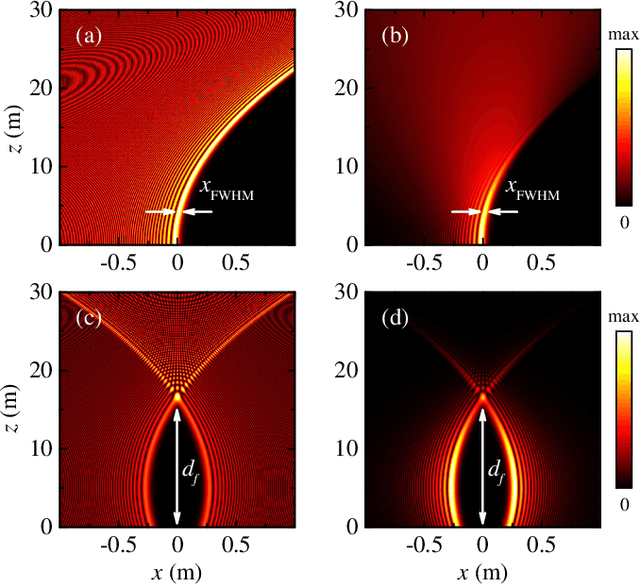
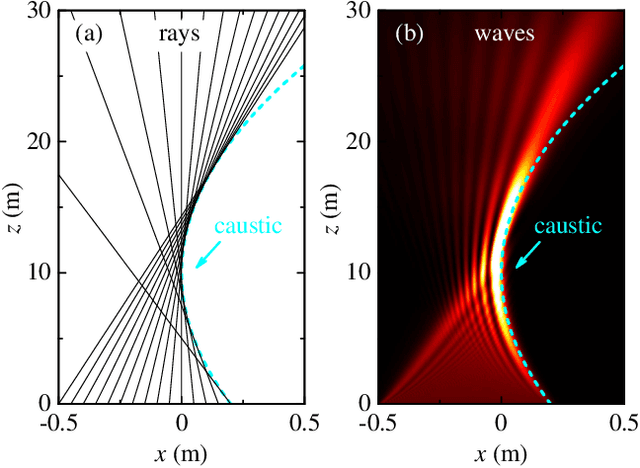
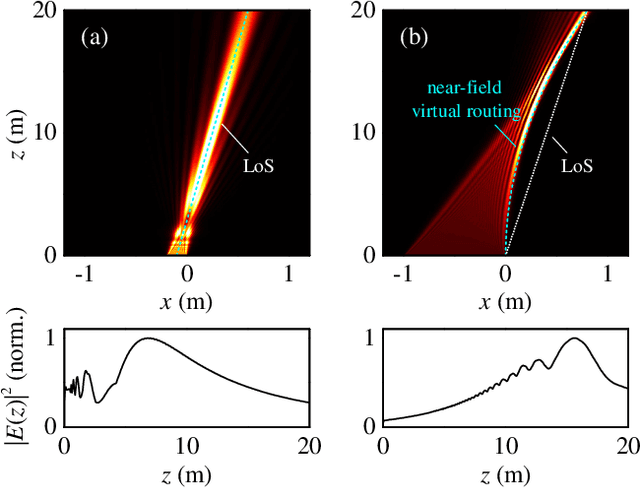
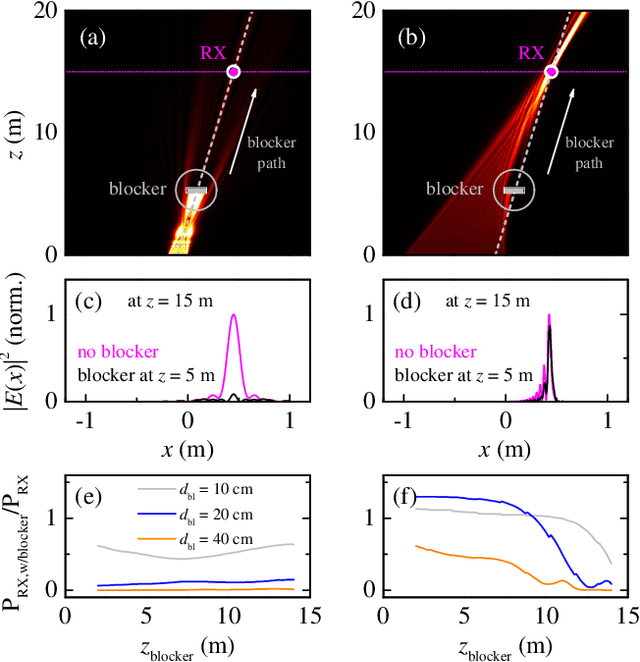
Abstract:Future wireless connectivity is envisioned to accommodate functionalities far beyond broadband data transmission over point-to-point direct links, enabling novel scenarios, such as communication behind blockers and around corners, and innovative concepts, such as situational awareness, localization and joint communications and sensing. In this landscape, beams that are able to propagate on bent paths are ideal candidates for dynamic blockage avoidance, interference management in selected regions, and user connectivity on curved trajectories. In this work, we study beam shaping for applications in near-field wireless connectivity. We explain the underlying mechanism of beam bending and we present the design principles for tailoring the curvature of the propagation trajectory. We discuss design aspects for generation of such beams with large arrays and analyze the impact of several parameters on their performance, including the beam's footprint shape, the aperture size, the inter-element spacing, the sub-array selection of active elements, the available phase levels of the array elements and the operating frequency. We introduce the concept of near-field virtual routing (NFVR) and we demonstrate that such beams are able to address challenges of high frequency communications, such as dynamic routing, blockage avoidance and energy-efficiency, more efficiently than conventional beamforming.
Hierarchical Localization for Integrated Sensing and Communication
Oct 01, 2024Abstract:Localization is expected to play a significant role in future wireless networks as positioning and situational awareness, navigation and tracking, are integral parts of 6G usage scenarios. Nevertheless, in many cases localization requires extra equipment, which interferes with communications systems, while also requiring additional resources. On the other hand, high frequency and highly directional communications offer a new framework of improved resolution capabilities in the angular and range domains. The implementation of integrated sensing and communications is being explored to unify the sensing and communications systems and promote a communicate-to-sense approach. To this end, a localization algorithm is presented that utilizes beam-forming and the emerging beam-focusing technique, to estimate the location of the receiver. The algorithm can be implemented with large antenna arrays, and large intelligent surfaces. The performance of the algorithm for static and mobile users is evaluated through Monte-Carlo simulations. The results are presented with the empirical CDF for both static and mobile users, and the probability of successful estimation for static users.
Reconfigurable Intelligent Surfaces as Spatial Filters
Aug 27, 2024Abstract:The design of Reconfigurable Intelligent Surfaces (RISs) is typically based on treating the RIS as an infinitely large surface that steers incident plane waves toward the desired direction. In practical implementations, however, the RIS has finite size and the incident wave is a beam of finite $k$-content, rather than a plane wave of $\delta$-like $k$-content. To understand the implications of the finite extent of both the RIS and the incident beam, here we treat the RIS as a spatial filter, the transfer function of which is determined by both the prescribed RIS operation and the shape of the RIS boundary. Following this approach, we study how the RIS transforms the incident $k$-content and we demonstrate how, by engineering the RIS shape, size, and response, it is possible to shape beams with nontrivial $k$-content to suppress unwanted interference, while concentrating the reflected power to desired directions. We also demonstrate how our framework, when applied in the context of near-field communications, provides the necessary insights into how the wavefront of the beam is tailored to enable focusing, propagation with invariant profile, and bending, beyond conventional beamforming.
Near-field orthogonality and cosine beams for near-field space division multiple access in 6G communications and beyond
Aug 23, 2024Abstract:Spatial division multiple access (SDMA), a powerful method routinely applied in multi-user multiple-input multiple-output (MIMO) communications, relies on the angular orthogonality of beams in the far field, to distinguish multiple users at different angles. Yet, with the gradual shift of wireless connectivity to the near-field of large radiating apertures, the applicability of classical SDMA becomes questionable. Therefore, to enable near-field multiple access, it is necessary to design beams that have the desired orthogonality in the near-field. In this work, we propose the concept of near-field space division multiple access (NF-SDMA), to enable SDMA in the near-field. We demonstrate analytically that the orthogonality of beams is preserved at any location of the receiver, from the near-field to the far-field of the transmitter. By judicious design, we select the family of cosine beams and we prove that they satisfy the orthogonality condition, offering a multitude of communication modes in the near-field. We demonstrate how the correlation of beams generated with uniform linear arrays (ULAs) is extended to uniform planar arrays (UPAs) in a straightforward and insightful manner. To test our analytical findings, we propagate the designed beams numerically, and we measure their orthogonality both at the transmitter and the receiver. We verify that the orthogonality of the proposed beams is successfully retrieved at a receiver that resides in the near-field of the transmitter, and is also robust to displacements of the receiver. Based on our findings, we propose codebook designs for NF-SDMA that are applicable for receivers with many elements and even with single antennas.
Perceptive, Resilient, and Efficient Networks assisted by Reconfigurable Intelligent Surfaces
Dec 02, 2023Abstract:Wireless communications are nowadays shifting to higher operation frequencies with the aim to meet the ever-increasing demand for bandwidth. While reconfigurable intelligent surfaces (RISs) are usually envisioned to restore the line-of-sight of blocked links and to efficiently counteract the increased pathloss, their functionalities can extend far beyond these basic operations. Owing to their large surface and the multitude of scatterers, RISs can be exploited to perform advanced wavefront engineering, essentially transforming the incident beam into a non-trivial reflected beam that is able to address the challenges of high frequencies more efficiently than conventional beam-forming. In this paper it is demonstrated how advanced wavefront engineering with RISs enables beam profiles that are able to focus, bend and self-heal, thus offering functionalities beyond the current state-of-the-art. Their potential as enablers of perceptive, resilient, and efficient networks is discussed, and a localization technique based on a hybrid beam-forming/beam-focusing scheme is demonstrated.
Analytical characterization of RIS-aided terahertz links in the presence of beam misalignment
Dec 12, 2022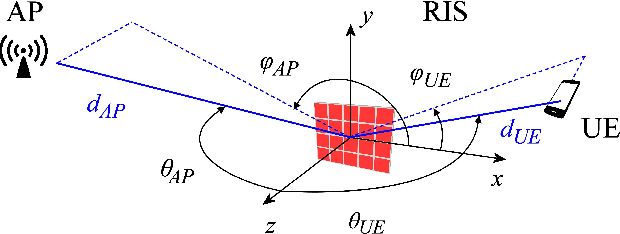
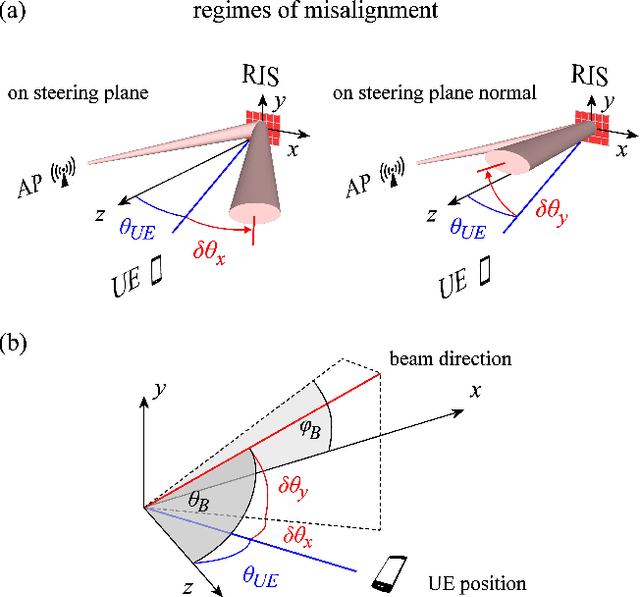
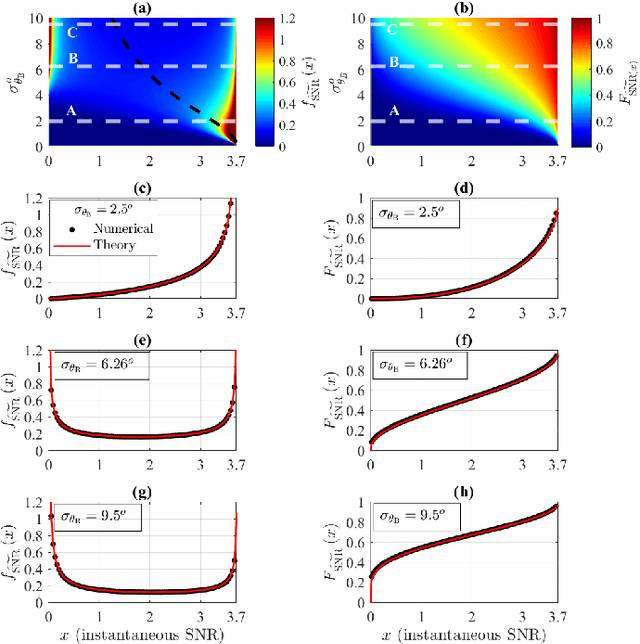
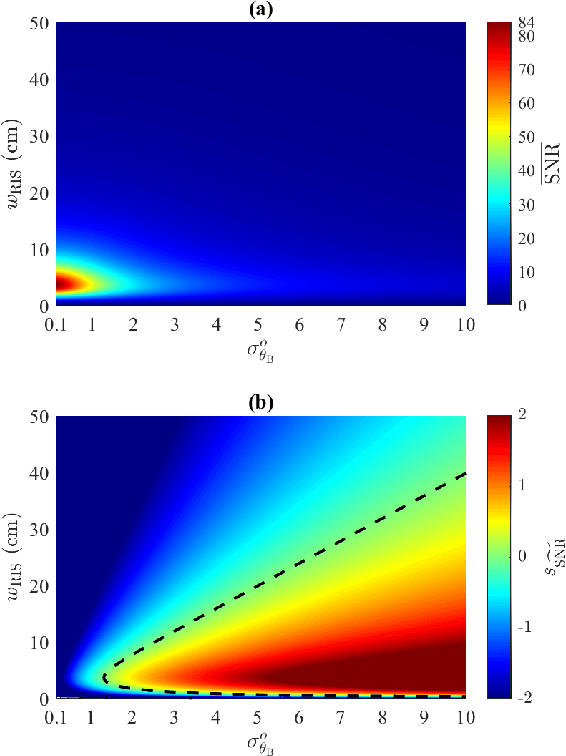
Abstract:The terahertz (THz) frequency band has recently attracted considerable attention in wireless communications as potential candidate for providing the necessary high bandwidth for demanding applications. With increasing frequency, however, the communication link becomes more vulnerable to blockage and pathloss increases. While both effects can be mitigated with the judicious utilization of directional beams and Reconfigurable Intelligent Surfaces (RISs), high directivity could potentially increase the probability of undesired misalignment between the beam that is steered by the RIS, and the user. It is therefore crucial to characterize and understand the stochastic behavior of misalignment in RIS-aided THz links. In this work, beam misalignment in RIS-aided links is studied theoretically and analytical models are derived, the validity of which is verified through numerical calculations. It is demonstrated that there is a distinction in the stochastic behavior of misalignment between pointing errors that occur on the steering plane or normally to the steering plane, with direct consequences on the link robustness on misalignment. The analytical models capture the impact of misalignment under these qualitatively different conditions and provide the necessary tools for assessing the stochastic RIS performance with respect to crucial link parameters, such as the transmitter's beam width, the transmitter-RIS distance, the RIS-receiver distance, and the steering angle of the RIS.
Reconfigurable Intelligent Surface: MIMO or radiating sheet?
May 18, 2022



Abstract:A Reconfigurable Intelligent Surface (RIS) redirects and possibly modifies the properties of incident waves, with the aim to restore non-line-of-sight communication links. Composed of elementary scatterers, the RIS has been so far treated as a collection of point scatterers with properties similar to antennas in an equivalent massive MIMO communication link. Despite the discrete nature of the RIS, current design approaches often treat the RIS as a continuous radiating surface, which is subsequently discretized. Here we investigate the connection between the two approaches in an attempt to bridge the two seemingly opposite perspectives. We analytically find the factor that renders the two approaches equivalent and we demonstrate our findings with examples of RIS elements modeled as antennas with commonly used radiation patterns and properties consistent with antenna theory. The equivalence between the two theoretical approaches is analyzed with respect to design aspects of the RIS elements, such as gain and directivity, with the aim to provide insight into the observed discrepancies, the understanding of which is crucial for assessing the RIS efficiency.
 Add to Chrome
Add to Chrome Add to Firefox
Add to Firefox Add to Edge
Add to Edge